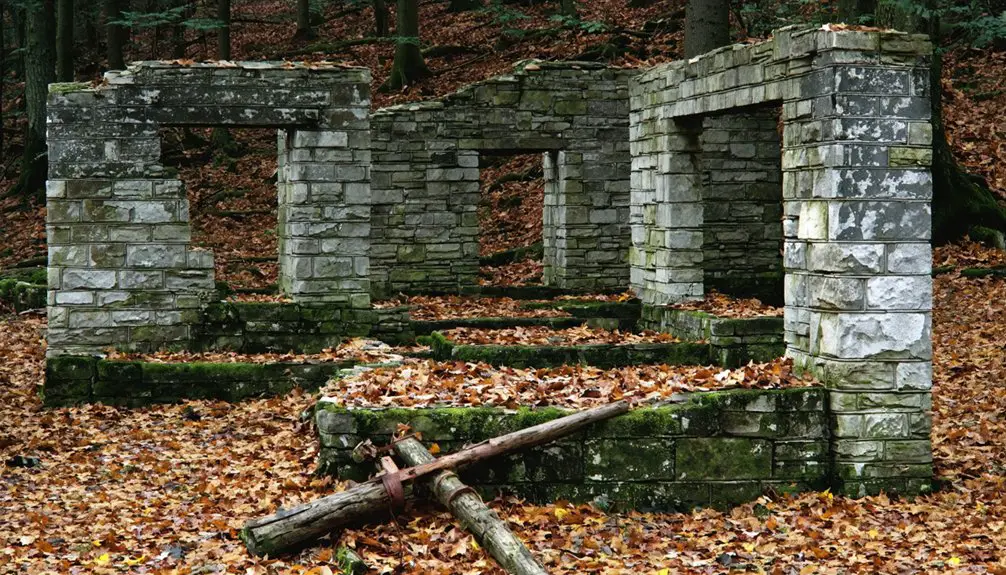You’ll find Ashland’s haunting ruins tucked away in Rhode Island’s woodlands, where colonial-era foundations and stone walls mark what was once a thriving settlement. Founded by the Herendin family in the late 1600s, this agricultural community mysteriously emptied between 1830 and 1900, leaving behind well-preserved wells, cellars, and the Alfred Smith Cemetery. Local legends about the haunted Ramtail Factory and Peleg Walker’s spirit add intrigue to this abandoned town’s compelling historical narrative.
Key Takeaways
- Ashland was a colonial settlement in Rhode Island that became completely abandoned by the early 1900s due to economic decline.
- The haunted reputation of the Ram Tail Mill, documented in the 1885 census, contributed significantly to the town’s abandonment.
- Archaeological remains include colonial-era stone foundations, a preserved well, and remnants of early settler homes dating to the 1600s.
- Original inhabitants were exiled Tories who faced persecution during the Revolutionary War and struggled with poor farming conditions.
- The Alfred Smith Cemetery and stone wall boundaries are among the few visible remnants of this ghost town today.
Origins and Early Settlement
While many colonial Rhode Island settlements grew into thriving towns, Hanton City began as a modest woodland community in the late 1600s when the Herendin family (later known as Harrington) established their homestead in what’s now Smithfield.
The settlement’s name evolved through settler traditions, as “Herendin” morphed into various forms before finally becoming “Hanton.”
Like many colonial place names, Hanton emerged gradually as settlers adapted and transformed the original Herendin family name.
You’ll find that the early community dynamics centered around agricultural pursuits and small-scale industry, with founding families receiving land grants to encourage growth.
They chose this location for its abundant natural resources, including timber and water sources essential for farming.
Other families joined the Herendins, creating a close-knit rural society that relied on kinship and cooperation to survive in their relatively isolated woodland setting.
The community utilized an ancient threshing rock for processing grain, which predated the arrival of European settlers.
Much like General Nathanael Greene’s own homestead established in 1770, the families here maintained traditional farming practices to sustain themselves.
Life in Colonial Ashland
Although colonial Ashland began as a modest settlement, it quickly developed into a vibrant community shaped by religious freedom and agricultural cooperation.
You’d find families working together during planting and harvest seasons, sharing labor and resources to guarantee everyone’s survival. Community gatherings centered around the meeting house, which served dual purposes as a place of worship and local governance. Roger Williams’s leadership helped maintain peaceful relations with local Native American tribes in the region.
Agricultural practices focused on crops adapted to New England’s climate, while trading posts facilitated commerce with Native Americans. Colonial farmers cultivated grains and flax along with other essential crops to sustain their families and contribute to trade. You’d see artisans like blacksmiths and carpenters supporting the farming economy, and families supplementing their food through fishing and animal husbandry.
The social structure remained relatively flat, with status determined by land ownership rather than aristocratic ties. Colonial Ashland’s religious tolerance attracted diverse settlers, often those seeking refuge from persecution elsewhere.
Archaeological Discoveries
Archaeological excavations at Ashland’s ghost town site, locally known as “Hanton City,” have revealed extensive colonial-era ruins dating to the late 1600s.
You’ll find remnants of stone structures with distinct markings across the woodland area, highlighting the archaeological significance of on-site quarrying activities. A well-preserved well stands among foundations and scattered stonework from colonial homes and farm buildings.
While you won’t encounter many personal artifacts like ceramics or metalwork, the site’s artifact analysis has uncovered various stone tools and building materials that tell the story of daily colonial life. Similar to other historical Rhode Island sites captured in Abandoned from Above, the area serves as a time capsule of early settlement life.
The quarried stones, some originally intended for Providence’s arcade building but abandoned due to imperfections, remain as silent witnesses to the settlement’s industrial ambitions.
Scattered across the landscape, imperfect stone blocks whisper stories of abandoned dreams and forgotten colonial industry.
Modern archaeological investigations employ non-invasive surveying techniques to protect this historically rich site. Similar to RIMAP’s approach, researchers use remote sensing technology to study the ruins without disturbing the grounds.
Mysterious Abandonment
In Ashland’s final years, you’ll find evidence of a calculated departure pattern where families quietly sold their properties and moved away, particularly after the Ramtail Factory’s haunted reputation spread through the workforce in 1885.
The once-bustling streets emptied as residents, faced with both supernatural fears and economic pressures from failing water-powered mills, sought opportunities in more promising locations. Much like other haunted Rhode Island locations, including the Providence City Jail, mysterious occurrences and unexplained phenomena plagued the town’s remaining inhabitants. The 1885 census officially documented the haunted reputation of the Ram Tail Mill, marking a turning point in the town’s history.
Historical records show the last documented residents left their homes in near-perfect condition, though they didn’t leave written explanations for their departure, adding to the town’s mysterious legacy.
Gradual Exodus Patterns
While historians have extensively documented Rhode Island’s ghost towns, Ashland’s gradual abandonment stands out for its mysterious decline spanning nearly seven decades. The migration trends began in the 1830s, with the last residents departing around 1900. Economic decline, driven by poor farming conditions and industrial opportunities elsewhere, prompted families to seek better prospects in urban areas. The settlement’s original inhabitants were exiled Tories who faced persecution during the Revolutionary War. Early settlers struggled with scratch farming techniques that yielded poor harvests among the rocky terrain.
- The Paine, Hanton, and Shippee families gradually disappeared from records.
- Failing irrigation infrastructure and poor soil quality made farming unsustainable.
- Isolation from major trade routes limited economic opportunities.
- Elderly population dwindled without younger generations to replace them.
- Industrial revolution drew residents to factory jobs in nearby cities.
The settlement’s remote location and limited resources ultimately sealed its fate, as nature slowly reclaimed what was once a thriving rural community.
Theories Behind Empty Streets
Several competing theories attempt to explain Ashland’s mysterious transformation from a bustling rural community into vacant streets and crumbling structures.
Economic shifts played a major role as nearby towns with superior market access drew away business, while the decline of local agriculture and timber industries stripped away essential livelihoods. Natural disasters, including floods and fires, damaged critical infrastructure, while soil exhaustion made farming increasingly difficult.
The cultural impacts were equally significant. You’ll find that epidemics might’ve decimated the population, while changing social patterns prompted younger residents to seek urban opportunities.
The closure of community institutions weakened social bonds, and local folklore about Peleg Walker’s spirit may have discouraged resettlement. These combined forces gradually turned Ashland into the silent town you see today.
Last Residents’ Silent Departure
As the nineteenth century drew to a close, Ashland’s final inhabitants quietly faded from historical record, marking the end of a settlement that had endured since 1676.
The silent memories of Tom Hanton and his sister, documented in an 1889 newspaper article “A Buried City,” offer the last glimpses into this dying community’s twilight years.
- No mass exodus or catastrophic event forced the residents away
- Isolation from Smithfield’s main areas contributed to the gradual decline
- Original English settler families remained until the end, with few newcomers
- Economic limitations and lack of modern infrastructure drove younger generations elsewhere
- Lingering echoes of their presence remain in stone foundations and untended burial grounds
The settlement’s final chapter closed around 1900, leaving only overgrown ruins to tell its story.
Local Legends and Folklore
At the heart of Ashland’s folklore, you’ll hear tales of mysterious lights and unexplained sounds emanating from the abandoned mill buildings, where workers reportedly died in industrial accidents during the 19th century.
You’ll find the most persistent stories center on the old colonial homesteads, where residents claim to have witnessed ghostly figures in period dress walking through walls and vanishing into thin air.
The legends blend the town’s industrial past with its colonial heritage, creating a rich tapestry of supernatural lore that continues to intrigue paranormal investigators and history buffs alike.
Haunted Mill Mysteries
The Ram Tail Factory stands as Rhode Island’s most notorious haunted location, officially recognized in the state’s 1885 census following decades of supernatural occurrences.
After Peleg Walker’s tragic suicide in 1822, the factory became a hotbed of paranormal activity, with haunted machinery operating mysteriously at night and ghost sightings that terrified local workers.
- The factory’s bell would toll at midnight, even after its rope was removed
- Water wheels turned against the river’s natural flow
- Looms and spindles operated on their own in the darkness
- Workers reported seeing Walker’s ghost carrying a lantern through the ruins
- Unexplained phenomena forced the entire workforce to abandon the mill
These events led to the village’s economic collapse and eventual desertion, cementing Ram Tail’s place in Rhode Island’s supernatural history.
Ghostly Colonial Tales
Deep within Rhode Island’s dense woodland lies Hanton City, a mysterious colonial settlement whose ghostly remains have spawned centuries of haunting tales.
Originally settled by three English families after King Philip’s War, this isolated farming community peaked in the 1730s before gradually fading into obscurity.
You’ll find more than just crumbling stone foundations and an old irrigation dam – locals have reported spectral sightings near the cellar remains since the late 1800s.
While historical records suggest a natural decline, folklore tells of plagues, land seizures, and Loyalist exiles.
The Providence Journal’s 1889 interview with the last inhabitants only fueled stories of ghostly encounters.
Today, Hanton City’s overgrown ruins serve as a haunting reminder of colonial life, preserving both historical truth and supernatural mystery in Rhode Island’s cultural tapestry.
Structural Remains Today

Hidden beneath dense New England forest, Ashland’s remaining structural elements provide compelling evidence of its colonial past through an array of stone foundations, agricultural remnants, and historic pathways.
You’ll find foundation features revealing cellar steps and spacious kitchen basements, while agricultural remnants like a stone-supported corn crib and irrigation dam showcase the settlers’ farming innovations.
- Stone walls mark property boundaries and former cultivated plots
- Colonial roads, including Hanton City Trail, trace historic transportation routes
- The Alfred Smith Cemetery preserves the final resting place of early settlers
- Foundation outlines showcase typical New England farmhouse architecture
- A stone dam system demonstrates early irrigation engineering
The site’s remote location has preserved these ruins, though they’re often concealed by thick vegetation except during winter months.
Historical Documentation
You’ll find sparse written records documenting Ashland’s early colonial period, with most historical knowledge derived from archaeological surveys and oral traditions passed through generations.
Regional maps from Rhode Island’s archives occasionally reference the settlement’s location, though they rarely provide detailed layouts of the community itself.
The limited primary sources that do exist consist mainly of property records and fragmentary accounts from neighboring towns, leaving significant gaps in the documented history of this ghost town.
Primary Sources and Records
While historical records of Hanton City remain scarce, several primary sources offer glimpses into the settlement’s existence and eventual abandonment.
Record preservation challenges have left researchers to piece together the settlement’s story through scattered documentation and physical remains.
- A 1937 Providence Journal article dates the abandonment to early 1800s based on tree growth patterns in cellar holes.
- 1880s newspaper accounts first introduced the “Haunted City” nickname, though locals disputed supernatural claims.
- Early 1900s written descriptions focus on remaining cellar holes and stone foundations.
- Land records preserve ancient pathways like Hampon City Trail and Rand Alders Trail.
- Regional census data from 1885 documents nearby settlements like Ramtail Factory village but omits direct mention of Hanton City.
Settlement Maps and Surveys
Historical maps and surveys from colonial New England reveal significant gaps in documenting Hanton City’s exact layout and boundaries.
You’ll find that early colonial-era maps of Smithfield and Providence regions don’t explicitly mark the settlement, suggesting it existed more as scattered farmsteads than a unified town.
The settlement patterns emerge through various mapping techniques, including land deeds, agricultural censuses, and modern GPS trails.
You’ll notice foundations showing cellar steps, corn cribs, and irrigation dams that align with typical 17th and 18th-century New England farming practices.
The archaeological evidence points to a dispersed arrangement of homesteads rather than a concentrated village center.
Today’s environmental surveys help locate buried cellar holes by identifying depressions and stone outlines in the rocky, wooded terrain.
Notable Residents and Families
The founding families of Hanton City – the Paines, Hantons, and Shippees – established this isolated New England settlement after receiving land grants, possibly as compensation for their service in King Philip’s War (1675-1676).
When you explore the historical record of this settlement’s residents, you’ll find:
- The Hanton family’s prominence led to the town’s naming, with their last resident dying around 1900.
- Thomas Vernon’s diary mentions Loyalist settlers being exiled to the area during the American Revolution.
- Local historian Jim Ignasher disputes the Loyalist exile theory, supporting the English settler family narrative.
- Genealogical records from the Alfred Smith Cemetery provide insights into early resident demographics.
- Most descendants of these founding families had moved away or integrated into other communities by the 20th century.
Visiting the Ghost Town
Nestled deep within Rhode Island’s wooded landscape, Hanton City’s ruins present unique challenges for modern-day explorers.
You’ll find this ghost town‘s stone foundations, walls, and cellar holes scattered throughout a densely vegetated area, making site navigation particularly demanding. Without official markers or facilities, you’ll need to rely on maps or GPS coordinates from local guides.
For successful visitor preparation, plan your trip during late fall to early spring when foliage thins out.
You’ll want sturdy hiking boots, water supplies, and weather-appropriate gear. The terrain’s uneven nature, with its forest undergrowth and stone rubble, requires careful footing.
While exploring the colonial-era remains, including an intact well and corn crib foundations, you’ll discover why this remote settlement continues to intrigue history enthusiasts.
Preservation Efforts
Preservation efforts at Hanton City primarily fall under the Rhode Island Historical Preservation & Heritage Commission’s jurisdiction, though limited resources have focused mainly on documenting and protecting the site’s remaining stone structures.
Despite preservation funding challenges, you’ll find community engagement through local historical societies and volunteer initiatives working to maintain this piece of colonial history.
Local communities and passionate volunteers step up where funding falls short, helping preserve our colonial past for future generations.
- Local preservation groups conduct periodic site clean-ups and monitoring
- Historical surveys catalog the remaining foundations, well, and cellar steps
- Community volunteers assist with documentation and public education efforts
- Educational programs and media coverage help maintain public interest
- Grassroots advocacy campaigns work to secure additional resources and protection
These preservation activities face ongoing challenges from natural decay, remote location access, and limited staffing, but dedicated local efforts continue to safeguard this unique historical site.
Frequently Asked Questions
Were Any Valuable Artifacts or Treasures Ever Discovered in Ashland’s Ruins?
Like empty treasure chests in video games, your artifact hunting won’t yield bounty here. Despite treasure legends, there’s no documented evidence of valuable artifacts or treasures ever being discovered in these ruins.
Did Native American Tribes Have Settlements in the Ashland Area?
You’ll find strong evidence of Narragansett tribal history in this region, where they established seasonal settlements, managed coastal resources, and left behind significant cultural significance through their traditional land use patterns.
What Natural Disasters or Epidemics May Have Affected Ashland?
Like shadows over the land, you’ll find floods and harsh winters tested settlers’ resolve, while tuberculosis outbreaks in the 1890s and other diseases brought death’s dark whisper to Rhode Island’s communities.
Are There Any Photographs or Paintings of Ashland Before Abandonment?
You won’t find any photographs or paintings from before abandonment – historical records don’t contain visual documentation. The town’s early 1800s desertion predates widespread photography, and no confirmed artworks survive.
How Did Ashland Compare in Size to Neighboring Colonial Settlements?
You’ll find that colonial architecture and settlement patterns show Ashland was particularly smaller than its neighbors, like Newport’s 7,500 residents and South Kingstown’s 12-square-mile territory – it remained a tiny outpost.
References
- https://www.rimonthly.com/haunted-places-rhode-island/
- https://en.wikipedia.org/wiki/Hanton_City
- https://www.youtube.com/watch?v=kpy7zlXYrAU
- https://www.youtube.com/watch?v=ooRMCNDJaCo
- https://www.youtube.com/shorts/VL2Ovb_A1Tg
- https://www.youtube.com/watch?v=rJHRzp9h3oM
- https://www.instagram.com/reel/CjBuLl_MCky/?hl=en
- https://www.srichamber.com/history.html
- https://en.wikipedia.org/wiki/History_of_Rhode_Island
- https://www.britannica.com/place/Rhode-Island-state/History



